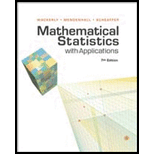
Provide an estimator of
Prove that the estimator is consistent.
Explain whether the estimator is a
Also provide the implication.
Answer to Problem 69E
The method of moments estimator of
Explanation of Solution
Calculation:
The expectation of the given random variable Y is obtained as follows:
Consider that the method of moments estimator of
Now, to obtained the method of moments estimator of
Hence, the method of moments estimator of
Now consider,
Thus,
Now,
The variance of Y is given as follows:
The variance of
Thus, the estimator
Now, using Law of large numbers it can be aid that
That is,
Hence,
The likelihood function of α can be written as follows:
Where
By Theorem 9.4 (Factorization theorem), it can be said that,
Hence, the estimator is estimator is not a function of the sufficient statistic
Therefore, it implies that it is not a minimum variance unbiased estimator.
Want to see more full solutions like this?
Chapter 9 Solutions
Mathematical Statistics with Applications
- Let Y₁, Y2,..., Y₁ denote a random sample from the probability density function f(y) = {0y⁰-1₁ 0 0. Show that Y is a consistent estimator of 0/(0+1).arrow_forward5)Let X1, X2, ..., Xn be a sample of n units from a population with a probability density function f (x I θ)=θxθ-1 , 0<x<1, θ>0 . According to this: Find a sufficient statistics for θ. Check if the statistics you have found are minimally sufficient.arrow_forwardLet X and Y random variables have independent Gamma distributions with X-Gamma(1, 6) and Y-Gamma(2, B). a. Find the joint probability density of Z, = X + Y, Z, = X+Y a. Find the marginal pdf of Z2.arrow_forward
- Let X be a (continuous) uniform random variable on the interval [0,1] and Y be an exponential random variable with parameter lambda. Let X and Y be independent. What is the PDF of Z = X + Y.arrow_forward1. Let X be a random number from (0, 1). Find the probability density function of Y = 1/X.arrow_forwardLet X be a positive random variable having the probability density function fx(x) and 1 Y = be a decreasing function for 0arrow_forwardLet X1,., X, denote a random sample from the probability density function f(r) = 0xº-1, 0 0. Show that X is a consistent estimator of .arrow_forward8)Let X1, X2, ..., Xn be a sample of n units from a population with a probability density function f (x I θ)=θxθ-1 , 0<x<1, θ>0 . According to this: Find the joint probability density function of the order statistics X(2), X(4), X(6) for n = 7.arrow_forwardLet X1, X2, . X6 be an i.i.d. random sample where each X, is a continuous random variable with probability density function f(x) = e-(-0) , x > 0 Find the probability density function for X(6).arrow_forwardSuppose that X and Y are independent and uniformly distributed random variables. Range for X is (−1, 1) and for Y is (0, 1). Define a new random variable U = XY, then find the probability density function of this new random variable.arrow_forward2. Let f(x, y) be the probability density function of the continuous random variable (X, Y). If U = XY, show that the probability density function of U is given by fu(u) = [ƒ€.) | dv. ( , v) |arrow_forwardLet X and Y be jointly continuous random variables with joint PDF cx +1, 2,y> 0, x+ y<1 0, fx,x (x, y) = otherwise. Then the constant c= And the probability that P(Y < 2X²) = ;: Here a = and b =arrow_forwardarrow_back_iosSEE MORE QUESTIONSarrow_forward_ios
 Glencoe Algebra 1, Student Edition, 9780079039897...AlgebraISBN:9780079039897Author:CarterPublisher:McGraw Hill
Glencoe Algebra 1, Student Edition, 9780079039897...AlgebraISBN:9780079039897Author:CarterPublisher:McGraw Hill
